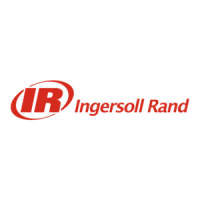
Do you have a question about the Ingersoll-Rand Sierra SM 55 and is the answer not in the manual?
| Model | Sierra SM 55 |
|---|---|
| Manufacturer | Ingersoll-Rand |
| Power Source | Electric |
| Motor Power | 55 hp |
| Phase | 3 |
| Type | Rotary Screw |
| Maximum Pressure | 125 PSI |
| Voltage | 460V |
| Tank Size | N/A (Base Mounted) |
Lists the EC Directives relevant to the product conformity.
Ensures operator reads decals and consults manuals before operation or maintenance.
Describes the Sierra compressor as an electric motor driven, two-stage, dry screw compressor package.
Details the normal and maximum allowable operating pressures for Ingersoll-Rand Sierra compressors.
Describes the system for collecting and ejecting condensation using solenoid valves.
Describes the oil sump, oil pump, oil cooler, and oil pressure regulation system.
Specifies the designed ambient temperature range for standard compressors and recommendations for other conditions.
Describes the intercooler, aftercooler, oil cooler, fan, and motor as an integral assembly.
Details water-cooled system components and operation, including heat exchangers and water flow.
Describes the electrical system, including the INTELLISYS controller and standard components.
Explains how the compressor controls its capacity.
Explains the function and operation of the automatic star-delta starter.
Describes the automatic start sequence in unloaded mode and subsequent loading.
Explains the automatic restart option after power interruption.
Explains the on-off line control mechanism based on plant air pressure.
Describes the capability of adding sequencer control via an interface.
Details the automatic start/stop function, including timing intervals and conditions.
Details the automatic start/stop logic, including timers A and B functions.
Describes the high condensate level switch option and its function.
Defines the delay load time and its function in the automatic start/stop sequence.
Key to diagram labels for installation and handling.
Specifies requirements for water piping, including size, isolation valves, and inspection.
Caution against operating the machine with panels removed due to overheating and noise exposure.
Details water flow requirements and temperature limits for proper compressor operation.
Table listing minimum water flow requirements for different SIERRA compressor sizes.
Provides instructions for checking motor rotation direction to prevent airend damage.
Describes correct motor rotation direction and checks for drive motor and fan motor.
Provides steps for commissioning the machine before placing it into service.
Instructions for secure and stable machine positioning to avoid movement and strain.
Warning about safe working pressure ratings for air pressure equipment.
Lists recommended acceptable ranges for water constituents for compressor cooling system.
Instructions for unpacking the compressor, including handling the cover and packing materials.
Caution regarding minimum clearance around the compressor for safety and exhaust management.
Warning about connecting multiple compressors to a common plant.
Explains scale formation, its causes (temperature, pH, calcium carbonate precipitation), and control methods.
Provides advice on selecting an appropriate installation location for the compressor.
Discusses corrosion, its causes (chlorides, low pH, dissolved oxygen), and factors influencing it.
Emphasizes reviewing the total air system for safe and effective installation, considering liquid carryover.
Guidance on discharge piping size and suitability for discharge pressure.
Pre-start checks and procedures for electric motor, personnel competence, safety procedures, and electrical connections.
Emphasizes the importance of water cleanliness and the use of proper water strainers.
Provides a step-by-step procedure for venting the water system after installation or draining.
Provides a procedure for completely draining the water system.
Discusses the importance of water quality and its impact on compressor performance.
Daily maintenance tasks: check oil level, air filter pressure differential, and condensate drain.
Procedure for changing air filter elements, including standard and high dust options.
Provides instructions for changing the engine oil and oil filter.
General guidelines for routine maintenance and safety precautions before starting work.
Post-maintenance checks: testing, refitting guards, closing panels, and containing hazardous materials.
Pre-maintenance checks including pressure discharge, safety measures, and electrical isolation.
Warning against opening drain valves or removing components without ensuring the machine is fully shut down.
Pre-opening checks: operator awareness of reduced protection, hazards, and ensuring machine cannot start.
Pre-maintenance checks for running machines: limiting tasks, disabling safety devices, knowing hazards, PPE, and signage.
Step-by-step instructions for replacing the compressor module input shaft seal.
Troubleshooting steps for compressor failure to start, checking fuses and connections.
Troubleshooting for compressor shutdown due to remote stop fault or starter fault.
Troubleshooting for high condensate level: checking drain system, valves, and strainers.
Fault code for low oil pressure, with troubleshooting steps.
Troubleshooting low system air pressure due to unload mode or low setpoint.
Troubleshooting air leaks: checking piping, manual and solenoid valves.
Troubleshooting unloading valve issues: checking hydraulic cylinder and replacing valve assembly.
Troubleshooting compressor failure to load.
Troubleshooting leaking seals in hydraulic cylinder.
Troubleshooting for defective load solenoid valve: checking tubes and replacing valve.












